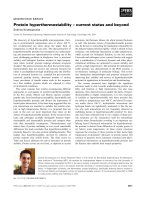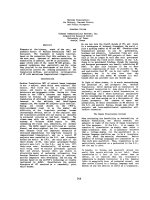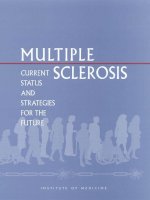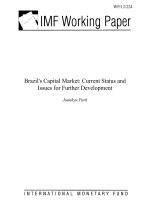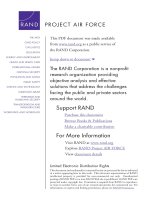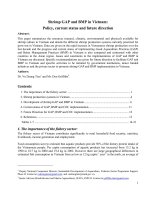Air pollution issues in hanoi current status and solution for air pollution management in climate change context
Bạn đang xem bản rút gọn của tài liệu. Xem và tải ngay bản đầy đủ của tài liệu tại đây (1.89 MB, 100 trang )
VIETNAM NATIONAL UNIVERSITY,
HANOI
b
VIETNAM JAPAN UNIVERSITY
NGUYEN ANH TUAN
AIR POLLUTION ISSUES IN HANOI –
CURRENT STATUS AND SOLUTIONS FOR
AIR POLLUTION MANAGEMENT IN
CLIMATE CHANGE CONTEXT
MASTER'S THESIS
i
VIETNAM NATIONAL UNIVERSITY, HANOI
VIETNAM JAPAN UNIVERSITY
NGUYEN ANH TUAN
AIR POLLUTION ISSUES IN HANOI –
CURRENT STATUS AND SOLUTIONS FOR
AIR POLLUTION MANAGEMENT IN
CLIMATE CHANGE CONTEXT
MAJOR: CLIMATE CHANGE AND DEVELOPMENT
CODE: 18110046
RESEARCH SUPERVISOR:
Dr. NGUYEN SY LINH
Dr. NGUYEN VAN QUANG
Hanoi, 2021
ii
PLEDGE
I assure that this thesis is the result of my research and has not been
published. The use of other research’s result and related documents must comply with
regulations. The citations and references to documents, books, research papers, and
websites must be in the list of references of the thesis.
AUTHOR OF THE THESIS
NGUYEN ANH TUAN
iii
TABLE OF CONTENTS
TABLE OF CONTENTS ............................................................................................ iv
LIST OF TABLES ....................................................................................................... vi
LIST OF FIGURES .................................................................................................... vii
ABSTRACT ...................................................................................................................x
CHAPTER 1. INTRODUCTION.................................................................................1
1.1. Overview ..................................................................................................................1
1.2. Research objectives ..................................................................................................2
1.3. Structure of the thesis ...............................................................................................3
1.4. Learning outcomes ...................................................................................................5
CHAPTER 2. METHODOLOGY ...............................................................................8
2.1. Framework of the study ............................................................................................8
2.2. Study area .................................................................................................................8
2.2.1. Location .................................................................................................................8
2.2.2. Topography, geomorphology ................................................................................9
2.2.3. Climate.................................................................................................................10
2.2.4. Meteorology.........................................................................................................11
2.2.5. Inhabitants ...........................................................................................................12
2.2.6. Socio-economic development situation ...............................................................13
2.3. Methods of study ....................................................................................................14
2.3.1. Data sources .........................................................................................................14
2.3.2. The method of data collection .............................................................................14
CHAPTER 3. CHAPTER 3: THEORETICAL BASIS AND PRACTICAL
EXPERIENCE IN AIR POLLUTION AND MANAGEMENT MEASURES IN
THE CONTEXT OF CLIMATE CHANGE .............................................................16
3.1
Air pollution .....................................................................................................16
3.1.1 Air pollution theory..........................................................................................16
3.1.2 Causes of air pollution .....................................................................................17
3.1.3 Effects from air pollution .................................................................................20
3.2
Practical air pollution management groups of measures .................................21
3.2.1 Legal tools ........................................................................................................21
3.2.2 Economic tools .................................................................................................22
3.2.3 Technical and ancillary tools ...........................................................................23
3.3
Climate change .................................................................................................24
3.3.1 Definition and causes of climate change .........................................................24
3.3.2 The context of climate change in Vietnam ......................................................25
3.3.3 Climate change scenarios for Vietnam ............................................................28
3.3.4 Scenarios on climatic extremes ........................................................................30
3.4
The linkage between air pollution and climate change....................................31
iv
3.4.1 The foundational relation between air pollution and climate change ..............31
3.4.2 The new approach of air pollution management in the context of climate
change ..........................................................................................................................32
CHAPTER 4: CURRENT SITUATION OF AIR POLLUTION IN HANOI .......33
4.1. Causes of air pollution in Hanoi .............................................................................33
4.1.1. Transportation activities ......................................................................................33
4.1.2. Industrial activities ..............................................................................................34
4.1.3. Construction activities .........................................................................................35
4.1.4. Living activities and waste treatment ..................................................................36
4.1.5. Other sources from sub-urban areas ....................................................................36
4.2. Air pollution condition in Hanoi ............................................................................37
4.2.1. Air pollution caused by PM2.5 .............................................................................39
4.2.2. Air pollution caused by PM10 ..............................................................................42
4.2.3. Air pollution caused by hazardous gases ............................................................42
4.2.4. Air pollution caused by unpleasant odor and noise .............................................44
4.3. Effects caused by air pollution in Hanoi ................................................................45
4.3.1. Effects of air pollution on humans ......................................................................45
4.3.2. Effects of air pollution on socio-economic development ....................................45
4.3.3. Effects of air pollution-related to climate change ...............................................46
4.4. Current air pollution management tools .................................................................47
4.4.1. Legal tool .............................................................................................................47
4.4.2. Economic tool ......................................................................................................55
4.4.3. Technical and auxiliary tools...............................................................................57
4.5. Sub-conclusion .......................................................................................................59
CHAPTER 5: PROPOSED AIR POLLUTION MEASURES ................................61
5.1. Practical air pollution management measures around the world ............................61
5.1.1. Beijing experience ...............................................................................................61
5.1.2. Seoul experience ..................................................................................................65
5.1.3. Japan experience ..................................................................................................68
5.1.4. Others nations experience....................................................................................71
5.2. Proposed air pollution management measure in the context of adapting to climate
change ............................................................................................................................72
5.2.1. Transportation ......................................................................................................72
5.2.2 Industry ............................................................................................................76
5.2.3 Energy and fuel ................................................................................................79
5.2.4 Other measures .................................................................................................81
5.3. Sub-conclusion .......................................................................................................85
CHAPTER 6: CONCLUSION ...................................................................................87
REFERENCES ............................................................................................................89
v
LIST OF TABLES
Table 2.1: Climate characteristics of Hanoi ..................................................................10
Table 2.2: Average population and population density of Hanoi..................................12
Table 4.1: Monthly average PM2.5 concentration from 2013 to 2019 ...........................41
Table 5.1: Euro 3 and Euro 5 emission limits ...............................................................74
vi
LIST OF FIGURES
Figure 2.1: Framework of the research............................................................................8
Figure 3.1: Particulate size of PM10 and PM2.5 ............................................................17
Figure 3.2: Changes of yearly average temperature (oC) (1958-2014) .........................26
Figure 3.3: Changes in yearly precipitation (%) (1958-2014) ......................................26
Figure 3.4: Changes in tropical cyclones (1959-2014) .................................................27
Figure 3.5: Changes in tropical cyclone developments with wind speeds of level 12 or
higher in the East Sea (1990-2015) ...............................................................................27
Figure 3.6: Trends of sea-level rise changes .................................................................28
Figure 3.7: Scenario on annual average temperature change ........................................29
Figure 3.8: Scenario on annual precipitation change ....................................................29
Figure 3.9: SLR scenarios (cm) .....................................................................................30
Figure 3.10: Flood risk corresponds to SLR of 100cm .................................................30
Figure 3.11: The relationship between Air pollution in the context of Climate change
.......................................................................................................................................33
Figure 4.1: PM10 and PM2.5 monthly average concentration in Hanoi 2018 .................38
Figure 4.2: Averaged PM2.5 concentration from 2012 to 2018 .....................................39
Figure 4.3: Monthly average PM2.5 concentration in the period 2013-2019 .................40
Figure 4.4: Annual average PM10 concentration in Hanoi from 2013 to 2018 .............42
Figure 4.5: Annual average SO2 concentration development at Nguyen Van
monitoring station ..........................................................................................................43
Figure 4.6: Organization chart of Vietnam implementing the UNFCCC .....................52
Figure 4.7: Air quality monitoring stations distribution in Hanoi .................................59
vii
LIST OF ABBREVIATIONS
APCA
Air Pollution Control Act
AQI
Air quality index
CC
Climate change
GHG
Greenhouse gas
GRDP
Gross regional domestic product
IGCC
Integrated Gasification Combined Cycle
INDC
Intended Nationally Determined Contribution
IPCC
Intergovernmental Panel on Climate Change
NDC
Nationally Determined Contribution
PM
Particulate matter
QCVN
National Technical Regulation
SLR
Sea level rise
TSP
Total suspended particles
UNFCCC
United Nations Framework Convention on Climate Change
VOC
Volatile organic compound
WHO
World Health Organization
viii
ACKNOWLEDGMENT
I would like to express my sincere gratitude to my supervisors Dr. Nguyen Sy
Linh and Dr. Nguyen Van Quang for providing invaluable guidance, comments, and
suggestions throughout my thesis. I am also grateful to all the lectures at the Vietnam
Japan University and Ibaraki University for their support towards the successful
completion of my studies.
Besides, I would also like to thank my friends and colleagues at the Institute of
Strategy and policy on Natural Resources and Environment for supporting me during
the entire data collection period and creating the best conditions for me to balance my
work and study.
Finally, I want to dedicate my success to my family for the encouragement and
support throughout my research process.
I submit this thesis of mine with great humility and regards.
ix
ABSTRACT
Air pollution is considered as a spot-on phenomenon amongst many problems
that urban areas are facing with. In Hanoi, the capital city of Vietnam, this is also
unavoidable. Furthermore, climate change and its side-effects are in-turn worsen the
atmospheric environment. Therefore, understanding the impacts and the relationship
between air pollution and climate change is critical to the air quality management in
Hanoi and its effort of striving for sustainable development down the road. To analyze
the condition of air pollution in Hanoi precisely, I have collected information at
national and local level (Hanoi) in dealing with the air pollution. Those are represented
by lots of solutions, which are divided into groups of managerial tools. Results showed
that air pollution causes a large number of negative effects both on human health, and
socio-economic development. It is also indicated that climate change makes air
pollution worse by increasing greenhouse gas concentration in the atmosphere.
Combining all of those, the thesis has learned profound experiences in air quality
management around the globe, then introduced groups of measures to reduce
emissions in Hanoi, ensuring the plan to respond to CC in Hanoi.
Keywords: air pollution, climate change, air quality management, greenhouse gas,
Hanoi
x
CHAPTER 1. INTRODUCTION
1.1. Overview
Climate change (CC) and the depletion of natural resources, environmental
pollution are two main topics that are of particular interest in the world and Vietnam in
recent years. Changes in the climate increase climate hazards such as natural disasters,
which affect socio-economic development achievements directly (Thang et al., 2010).
Simultaneously, the rapid but unsustainable development of the economy in the past
few years in Vietnam has led to the decline of natural resources and environmental
pollution, especially the degradation of air quality (Vietnam Ministry of Natural
Resources and Environment, 2018).
One of the most visible features of CC is the increase in the concentration of
greenhouse gases in the atmosphere. Greenhouse gas emissions are a direct product of
socio-economic development and the global picture of greenhouse gas emissions is the
irradiation of the economic and social picture on the world scale (Thang et al., 2010).
These kinds of substances are also the main sources that cause air pollution. For 7
years from 2013-2019, Hanoi's atmosphere was in a polluted state. Considering PM2.5
dust concentration parameters, all the year the dust concentration exceeds the national
standard limit and many times higher than the recommendations from WHO.
However, the evolution of dust concentration has changed a lot, in 2013 the dust
concentration had the highest value with an annual average of 55.9 μg/m3 and then
continued to improve in the next 2 years with respectively, 49.2 μg/m 3 and 45.1 μg/m3.
Then again increased sharply in 2016 with a dust concentration of 50.5 μg/m 3 and then
continued to decline in the period 2017-2019. Air pollution brings enormous damage
to humans in Hanoi through the highest mortality statistics. The evidence for this is the
fact that every year our country has about 60,000 deaths due to constant exposure to
polluted air, this number reaches 7 million people each year worldwide. This shows
that air pollution also brings a greater risk of death than malaria, cancer, and traffic
accidents (Vietnam Ministry of Natural Resources and Environment, 2018).
1
Many pieces of research have shown that CC and air pollution share many close
relations. Climate changes directly result in impacts to air quality in a specific area.
The increasing of the temperature related to CC increases the ground-level ozone in
many regions, which may bring challenges and difficulties in complying with ozone
standards down the road. In turn, the emissions of pollutants into the atmosphere such
as particular matter (PM) can have whether warming or cooling effects on the climate.
At the present, researches into the impact of CC on air pollutants and in reverse is less
certain, however, they underway progress to address those uncertainties. Thus, I have
chosen the topic "Air pollution issues in Hanoi – Current status and solutions for air
quality management in CC context” to find out the main reasons that cause air
pollution, how CC and air pollution interact with each other, and how to improve the
air quality management in the context of CC.
1.2. Research objectives
This research is conducted to identify a set of feasible measures for tackling air
pollution in the context of current CC – one of the most significant dangerous
phenomena at the present that affect all aspects include humans, social life, the
economy, and the environment. My research, in detail, aims to solve three main
questions:
- What is the specific current status of air quality and its managerial condition
in Hanoi?
- How air pollution and CC interact with each other?
- What can be done in reality to deal with air pollution in the context of CC?
Concerning those questions profoundly, 5 key activities were conducted to
address three research questions:
(1) to collect the data of Hanoi’s socio-economic development status;
(2) to collect the data of and air pollution condition in Hanoi (including data on
PM2.5 concentrations, air quality index);
(3) to analyze the current air pollution situation in Hanoi;
2
(4) to collect the condition of CC management in Hanoi and the correlation
between CC and air pollution;
(5) to propose solutions to handle air pollution in the context of CC.
1.3. Structure of the thesis
The thesis is organized into 6 chapters as below:
Chapter 1: Introduction
Overview
Research objectives
Structure of the thesis
Learning outcomes
Chapter 2. Methodology
Framework of the study
Study area
Methods of study
Chapter 3: Theoretical basis and practical experience in air pollution and
management in the context of climate change
Air pollution
Practical air pollution management measures
Climate change
The linkage between air pollution and climate change
Chapter 4: Current situation of air pollution in Hanoi
Causes of air pollution in Hanoi
Air pollution condition in Hanoi
3
Effects caused by air pollution in Hanoi
Current air pollution management tools
Sub-conclusion
Chapter 5: Proposed Air pollution measures
Practical air pollution management measures around the world
Proposed air pollution management measure in the context of adapting to
climate change
Sub-conclusion
Chapter 6: Conclusion
4
1.4. Learning outcomes
Results of the Master’s thesis
Program Learning Outcomes (PLOs) of the MCCD
The thesis gave the fundamental knowledge and information about
PLO1: Mastering the fundamental, interdisciplinary knowledge and
air pollution, climate change, and its relationship briefly. The air
methodologies to assess and address actual problems (fate and
pollution is approached by the author considering the condition of
features) related to CC mitigation, adaptation for sustainable
climate change, pointing out the main causes, and proposing
development at global, national, and local levels
feasible measures to address the problem.
The thesis found a knowledge gap between the efforts of reducing
PLO2: Understanding and developing systematic thinking; air pollution and responding to climate change in Vietnam. These
necessary knowledge on science, technology, innovation, and are not closely related to each other. I have analyzed the air quality
governance-related to CC response for development; identifying, condition in Hanoi, along with the trend of climate change. When it
analyzing, assessing, and forecasting the issues related to CC and comes to proposing measures in dealing with the problem,
CCR; predicting the developing trend of CC science
modelling tool in air pollution and climate change management
appears as a significant trend afterward.
PLO3: Applying knowledge to solve the problems in CC and CCR: The thesis approached the problem in dealing with air pollution by
planning and approaching the works in the field of CC; proposing the approach of responding to climate change. Management of air
the initiatives as well as the researches on CC; implementing the quality in the context of climate change in general needs to be
5
Results of the Master’s thesis
Program Learning Outcomes (PLOs) of the MCCD
solutions on science, technology, mechanism, policy and finance carried out in a “no border” approach. Specifically, the proposed
for CCR and development
solutions must be interdisciplinary, inter-regional, and international
cooperation (if any) will bring greater efficiency.
PLO4: Having skills of cooperation with personal, agencies,
In terms of collecting data, I have strong cooperation with the
organizations domestically and internationally to solve the CC
Institute of Strategy and Policy on Natural Resources and
issues, communication in works, projects on CC; and organizing,
Environment and their network.
managing and administrating advanced career development
PLO5: Accumulating soft skills to self-directed and adapt to
competitive working environment such as English proficiency (at Studying and working at the same time give me chances to enhance
level 4/6 according to English competencies Framework for my skills of time management, self-discipline, self-determination,
Vietnam), Japanese communication skills; having skills on time and independent researching.
management; using the basic computer skills proficiently; working Besides using English in communication and writing reports,
and researching independently; having skills of research and thesis; knowing a little Japanese will make a friendly environment
development; and using technologies creatively in academic and between student and other Japanese professors.
professional fields
PLO6: Having social/community’s responsibility and professional The thesis results show the relationship between air pollution and
6
Results of the Master’s thesis
Program Learning Outcomes (PLOs) of the MCCD
morality, especially for the scientific research results; being able to climate change and the effects combined. Air pollution can affect
adapt to multicultural environment, ensure the harmony between all sectors of society. It can also worsen the condition of climate
the stakeholders, CCR and development; having good social change by increasing pollutant concentration. Hence, researching
morality, assist the vulnerable people to climate change; and proposing solutions to address the situation indicate my social
compliance with the law; discipline at work and positive lifestyle; responsibilities.
having good attitude to their career in climate change response for
sustainable development
7
CHAPTER 2. METHODOLOGY
2.1. Framework of the study
Figure 2.1 demonstrates specifically each stage of the whole research. Since
this kind of research mainly focuses on managing aspects, the availability and
sufficiency of input data is a prerequisite. The thesis bases on two main foundational
data, Hanoi socio-economic situation and monitoring data collected from monitoring
stations within Hanoi. These will help in analyzing the current contaminated air
quality in Hanoi. This will be summarized and assessed with the information of current
air pollution management in and the condition of climate change and its recent
management policies in Hanoi. As regards the analysis results, a set of potential
solutions will be proposed with the intention of solving and enhancing the condition of
air pollution in Hanoi towards adapting to CC.
Figure 2.1: Framework of the research
2.2. Study area
2.2.1. Location
Hanoi is the capital of the Socialist Republic of Vietnam. This city is located in
the middle of the fertile Red River Delta, which soon became a political, economic,
and cultural center from the dawn of Vietnam's history.
8
Figure 2.1: Location map of Hanoi
Hanoi is located northwest of the heart of the Red River Delta. It is located
from 20°53' to 21°23' north latitude and 105°44' to 106°02' east longitude, adjacent to
the provinces of Thai Nguyen, Vinh Phuc in the north, Ha Nam, Hoa Binh in the
south, Bac Giang, Bac Ninh and Hung Yen in the east, Hoa Binh and Phu Tho in the
west. Hanoi is 120 km from Hai Phong the port city, 87 km from Nam Dinh city,
forming 3 main poles of the Red River Delta. After the expansion of administrative
boundaries in August 2008, the city has an area of 3,324.92 km², located on both sides
of the Red River, but mainly on the right bank.
2.2.2. Topography, geomorphology
Hanoi's terrain is lower in the direction from north to south and from west to
east with an average altitude of 5 to 20 meters above sea level. The hills are
concentrated to the north and west of the city. Thanks to the alluvial sediment, threequarter of Hanoi's natural area is the delta, located on the right bank of the Da River,
on both sides of the Red River, and treating other rivers. The hilly area is mostly in
Soc Son, Ba Vi, Quoc Oai, My Duc districts, with high peaks such as Ba Vi (1,281 m),
Gia De (707 m), Chan Chim (462 m), Thanh Lanh (427 m), Thien Tru (378 m)... The
9
urban area has several low hill mounds, such as Dong Da mound, Nung Mountain.
Hanoi has four extreme points:
- The Northern side is Bac Son commune, Soc Son district;
- The Western side is Thuan My commune, Ba Vi district;
- The Southern side is Huong Son commune, My Duc district;
- The Eastern side is Le Chi Commune, Gia Lam district.
2.2.3. Climate
Similar to other provinces in the North, the climate in Hanoi is monsoon
tropical with cold winters, sometimes with frost and little rain, lasting from November
to March next year. The summer season in Hanoi is hot, combined with lots of
thunderstorms and cyclones, lasting from April to October.
The annual precipitation in most places ranges from 1,500 - 2,100mm in the
lowlands and from 1,600 - 2,600mm in the high mountain Ba Vi. The rain is
concentrated during summer. The precipitation in the six months of summer accounts
for 80-90% of the annual precipitation (Hanoi People’s Committee, 2012).
Table 2.1: Climate characteristics of Hanoi
Climate data of Hanoi
Month
1
2
3
4
5
6
7
8
9
10
11
12
Yea
r
Record
high °C
32.0 34.7 37.2 39.0 42.8 42.5
40.
39.
38.2
1
0
35.
5
34.7 31.5 42.8
Average
high °C
19.7 20.1 22.9 27.2 31.4 32.9
33.
31.
32.3
1
2
28.
8
25.3 22.0 27.2
Average
day, °C
16.4 17.2 20.0 23.9 27.4 28.9
29.
27.
28.6
2
5
24.
9
21.5 18.2 23.6
Medium
low, °C
14.3 15.3 18.1 21.7 24.6 26.1
26.
24.
26.0
3
9
22.
3
18.9 15.6 21.2
Record
low, °C
2.7
6.0
6.0
11.8 17.2 20.0
21.
16.
20.0
0
9
13.
0
10.0
5.0
2.70
Precipita
tion, mm
(inches)
18
19
34
105
25
3
156
59
20
1.61
165
266
10
274
24
3
%
82.
87.
80.9 83.4 87.9 89.4 86.5 82.9
85.9
humidity
2
2
84.
2
81.9 81.3 82.0
Number
of rainy
days
15.
13.
16.9
6
6
10.
9
7.9
5.0
152.
1
19
5
167
137
124
1.58
5
Average
monthly
sunny
hours
10.3 12.4 16.0 14.4 14.5 14.6
74
47
47
90
183
172
174
17
6
Source #1: Vietnam Institute for Building Science and Technology
Source #2: Pogoda.ru.net, (Record the highest temperature in May 1926, lowest January
1955),
Average winter temperature: 16.4 °C (as low as 2.7°C). Summer average:
29.2°C (highest at 42.8°C). The average annual temperature is 23.6°C, with an average
annual rainfall of 1,800mm to 2,000mm. In May 1926, temperatures in the city were
recorded at a record 42.8°C (42.8°C). In January 1955, temperatures dropped to their
lowest level, 2.7°C due to La Nina. In early June 2017, affected by El Niño
worldwide, Hanoi suffered a week-long heatwave (31-5 to 6-6) with temperatures of
up to 42.5°C, a record temperature recorded in history. Moreover, due to the influence
of urban effects and the climate with high humidity, the heat waves, the actual
temperature is always higher than the measurement level, can be up to 50°C. During
this heatwave two people died from the heat, in the future things are even more
terrible. In Hanoi in 2100, summer will last longer and there will appear a temperature
of 48°C, the temperature is felt from 55-58°C. The place with snow in winter in Hanoi
is Ba Vi around 6 am on 24th January of 2016 with a temperature of about 0°C.
2.2.4. Meteorology
The Red River is the main river of the city, starting to flow into Hanoi in Ba Vi
district and out of the city in the area where Phu Xuyen district adjacent to Hung Yen,
then down to Nam Dinh, the city that has been associated with Thang Long since the
Tran Dynasty. Hanoi also has the Da River which is the boundary between Hanoi and
Phu Tho, which is associated with the Red River in the north of the city in Ba Vi
district. Also, in Hanoi, there are many other rivers such as The River, Duong River,
Cau River, Ca Lo River... Small rivers flowing in the inner city such as To Lich River,
Kim Nguu River, (To Lich River is processing). These are the sewage drainage routes
11
of Hanoi.
Hanoi is also a special city with many lakes - traces of ancient rivers. In the
inner city, West Lake has the largest area, about 500 hectares, plays an important role
in the urban landscape, today surrounded by many hotels, villas. Hoan Kiem Lake is
located in the historic centre of the city, the busiest area, always holds a special place
for Hanoi. In the inner city can be mentioned other lakes such as Truc Bach, Tuyen
Quang, Thu Le. Besides, there are many large lakes located in Hanoi such as Kim
Lien, Lien Dam, Ngai Son - Dong Mo, Suoi Hai, Meo Gu, Xuan Khanh, Tuy Lai,
Quan Son.
2.2.5. Inhabitants
Hanoi is the largest centrally-owned city in the country since the merger of Ha
Tay province, and the second-largest locality in terms of population with nearly
8,053,663 people (as of 0h April 1, 2019), just after Ho Chi Minh City.
Table 2.2: Average population and population density of Hanoi
Average population
Population density
(1,000 people)
(person/km2)
2011
6,713.3
2,031.1
2012
6,865.2
2,065.6
2013
6,977.0
2,098.8
2014
7,095.9
2,134.0
2015
7,216.0
2,171.0
2016
7,328.4
2,182.0
2017
7,420.1
2,209.0
2018
7,520.7
2,239.0
2019
8,093.0
2,410.0
Year
Source: General Statistics Office
Hanoi is struggling to deal with pressure from population growth pressures and
mechanical population growth (Hanoi Statistical Office, 2019). On average, the
capital's population increases by about 160,000 people each year, approximately one
large district. The proportion of the population in urban areas increased rapidly from
12
36.8% to 49.2% between 1999 and 2019, proving that the pace of urbanization is
going strong. Districts such as Dong Da, Thanh Xuan, Hai Ba Trung, and Cau Giay
are the places with the highest population density in the city, namely: 37,347
people/km2, 32,291 people/km2, 29,589 people/km2, and 23,745 people/km2. In
addition, newly established districts such as Hoang Mai, Nam Tu Liem, Bac Tu Liem,
and Ha Dong have also become areas with a large population density no less than the
central districts. Another problem is that population allocation in districts is also
relatively disparity, the two districts with the highest population density are Thanh Tri
(4,343 people/km2) and Hoai Duc (3,096 people/km2), which is 4-6 times higher than
sparsely populated districts such as Ba Vi (687 people/km2) and My Duc (884
people/km2).
The population size in the period 2009 to 2019 increased by 1.66 million
people, the inner city alone increased by over 1.3 million people, largely increasing the
meson from immigrants. The average population growth rate is 2.22% per year, higher
than the period 1999-2009 is 0.13%. Hanoi is facing the problem of ensuring a
reasonable population size. Specifically, there are 32 wards and communes in Hanoi
with the proportion of immigrants accounting for over 30% of the population, located
mainly in areas that are very strong urbanization and unusual mechanical fluctuations
such as Cau Giay, Thanh Xuan, Ha Dong, Nam Tu Liem, Bac Tu Liem. Newly built
urban areas will solve the problem of accommodation for migrant flows, but this is
also the reason why traffic is often overloaded, arterial roads are clogged at work and
home from work, entailing many other environmental and urban management
problems.
2.2.6. Socio-economic development situation
According to the General Statistics Office, in 2019, Hanoi is the 2nd
administrative unit in Vietnam in terms of general products in the area (GRDP),
ranked 8th in GRDP per person, 41st in terms of GRDP growth rate. GRDP reached
VND 971,700 billion (US$41.85 billion), GRDP per person reached VND120.6
million (US$5200), GRDP growth rate was 7.62%. The GRDP structure in 2019
shifted in a positive direction, increasing the proportion of the service and industrial
sectors, construction, reducing the proportion of agriculture, forestry and fisheries: The
13
agricultural, forestry and fisheries sectors accounted for 1.99% of GRDP; industrial
and construction sectors accounted for 22.69%; the service sector accounted for
64.02%; product tax minus product subsidies accounted for 11.3%.
According to the General Statistics Office, in 2020, the city's economic growth
slowed due to the impact of the Covid-19 pandemic. In the first 6 months of 2020,
total production in the area is estimated to increase by 3.39% (same period increased
by 7.12%), while the industrial production index is estimated to increase by 3.07%
(same period increased by 7.4%), the total flow of goods and service revenue is
estimated to increase by 4.6% (same period increased by 10%), the total number of
tourists reached 4.93%, decreased by 65.4% (same period increased by 9%).
The situation of epidemic prevention of the city is also implemented effectively
and quickly, ensuring the best health for residents. With the efforts of the whole
political system, especially the health system, in the first 6 months of 2020, 118 cases
of Covid-19 infection are cured; in the long run, there have been no out-of-community
infections. The city establishes a "new normal" and focuses on implementing the "dual
goal" – both disease prevention, recovery, and maintenance in the last months of the
year.
2.3. Methods of study
2.3.1. Data sources
- Using secondary data: The data used related to the status of air pollution in
Hanoi, including data on PM2.5 dust concentration, air quality index, number of cases
related to air pollution.
- Data source is taken from the monitoring station Nguyen Van Cu, from the air
quality monitoring station at the US Embassy in Hanoi, from AirNow, from the
Vietnam Environment Administration, and related reports and articles.
2.3.2. The method of data collection
- Inheritance method: summarizing and analyzing data, materials, and
information related to air pollution in Hanoi:
14
+ The concentration of air particulate matter, the concentration of greenhouse
gases, including Sulfur dioxide, Nitrogen oxide, Carbon dioxide, and Trioxide;
+ Air pollution causing agents;
+ Affection of air pollution on the environment and people.
- Methods of collecting information: collecting information from the Air
Pollution curriculum, collecting data on activities that cause air pollution and
parameters of air pollution, related articles, and reports.
- Comparative method: used to analyze the status of air pollution in years, the
evolution of particulate concentration in the period of 2013-2019, and conclude the
trend over time.
- Data processing method using tools such as Microsoft Excel, SPSS to
calculate and tabulate results.
15



